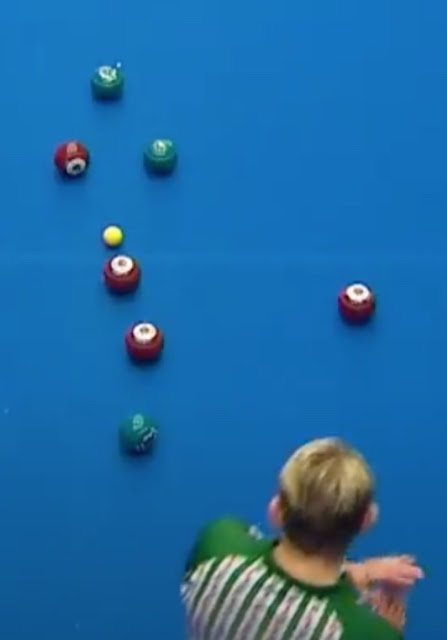I wanted to write a blog article about 'bowling into danger' but in searching for what had already been written I found this article by Ezra R. Wyeth from 1966. It is my pleasure to reproduce it here where such good advice can be found more easily!
https://www.bowlsusa.us/uploads/7/5/9/0/75903269/1966-02.pdf
I find two important differences between bowling in the U.S.A. and elsewhere, and they both amount to the same thing - an unbelievable waste of bowls by many of our players. The first is the use of the block and the second is the attempt to match a catcher. I have never consciously played a block and only in dire extremity have I tried the other-both for the same reasons. Firstly, they require more skill than I possess; secondly, there are usually easier and more productive shots available. If you will be patient for a while, I will try to explain about matching the catcher.
Let me start with a head like this.
Playing the forehand, the lead has drawn a jack-high bowl, slightly wide, six inches from the jack. His opponent has followed with a bowl a foot behind and to the left. It is a safe bet that in 99 cases out of 100, the player by choice ( or at the direction of his skip ) will change his hand. He does this for three reasons. He believes the jack will be shifted; he can anticipate the direction it will go; and lastly; he thinks he can draw to a spot on the green. If he is completely honest he would admit to himself that he has little right to believe any of these reasons. If, on the other hand, he is stubborn and refuses to face the facts he will just have to count the number of times during a game that his beliefs are proved true.
Only a superman could do what hundreds of players try to do each time they play. For any player the choice is simple. Either he plays like a superman or he assumes human status and plays an easier shot. The thing to do in the situation described above is to play the shot his opponent must play. His opponent has the choice of three shots:
- draw the shot anywhere within a twelve-inch circle
- play to reach the shot with enough strength to take its place or to turn in off it
- try to trail the jack
The second is by far the best shot to play as it offers a greater margin for error. Our player, therefore, tries to play just that shot- and for about seven good reasons.
Examine all the possible outcomes. If he is short he can draw a second shot in a semi-circle, 24 inches in diameter. If shorter, he can well finish on a line that appears to be in his opponent's draw. If he gets his objective, he will have two shots. If he manages to turn his own bowl in or to wick off it, he will have an excellent position. If he has the right weight, or slightly less, and misses his first bowl he can draw a shot in a position to the right or left of his opponent's bowl.
If his weight is right and he trails the jack he may lose the shot. Even so, he still has two bowls close to the shot, and his chances of losing more than one shot are reduced. There are other possibilities. If he is heavy he can take his other bowl out or shift the jack, or he can have a bowl behind the jack. If you are one of the stubborn ones and feel that in this last paragraph, I have undermined my position, please remember that these things can and do happen if a player changes his hand.
Before you dismiss everything I have said, let me offer the most important reason of all. One of the delights of playing lead or singles is that a player can usually play the better side of the rink. The greens we play on rarely draw the same on both sides and one side is often faster than the other. It is usually much easier to play either the wide side or the narrow side consistently. A change of side means a change of green and a change of pace with a consequent increase in the chance of error. If you want more convincing proof than my arguments, you'll find it on the green. Borrow two bowls and place them in the positions shown above and try all the shots you like. The results will amaze you.








